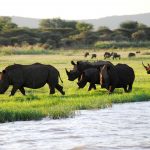All 5 species of rhino are herbivores: a mix of grazers and browsers. You can tell which they are by the shape of their top lip. No rhino actively eats meat.
Do Rhinos Eat Meat: Are They Carnivores?
Absolutely not. Rhinos are not carnivores. They have a specialised set of teeth and a gut system that just doesn’t allow for meat consumption – let alone catching anything first.
Rhinos can run fast for sure – but they would have to suck their prey to death. Most rhinos don’t even have front teeth at the top?
There are 5 species of rhino in the world currently; 2 in Africa – the White Rhino and Black Rhino, and 3 across Asia and South-East Asia – the Indian, Sumatran and Javan rhinos. All 5 are plant-eating.
Their closest living relatives are the tapirs – smaller, but still quite rhino-like with their body shape, woodland habitat, and herbivorous diets. They are more distantly related to horses – also herbivorous.
Rhinos may occasionally be seen sniffing at or tasting carcasses or exposed bones out of interest – but also because their herbivorous diet often leaves them craving salt (sodium). Usually, they would find their salt at various salt licks near rivers – but often animals lick bones for the same ‘feel’.
What Do Rhinos Eat In The Wild?

Naturally, rhinos eat a variety of plant materials found commonly in woodlands, but also on open grassland.
Three species are known as browsers – and have pointed top lips (for grabbing and tearing things), and two are mainly grazers (with flat top lips for grasping grass and ripping it from the ground).
White Rhinos and Indian Rhinos are both straight-lipped ground-grazers. They spend hours each day plodding along wide open spaces, pulling up grass to feast on. Some can eat 50kg (110lbs) or more of grass and flowers a day. Being such large animals (about 4 tonnes (8800lbs)) – they need to bulk up on this grass and plant material as it has very low nutritional content. However, it is an easy meal.
Black, Sumatran, and Javan rhino, on the other hand, work a bit harder to get their dinner. Working at head height – they eat mainly leaves, twigs, shoot, and saplings by walking into, or leaning on young trees. They cause them to bend over so the tasty bits are then at mouth height. Using their prehensile top lip, they can feel their way around the foliage and pull off the tasty bits.
Rhinos may change their food slightly depending on the season or region they are in – with some rhinos eating over 200 different types of plants. They tend to prefer the more tender plants and parts of trees – but will also eat the bark and thicker plant materials to gain different nutrients during certain seasons.
The Indian Rhino has also been known to dine on aquatic plants too. With a natural tendency to rivers and wallows, all rhinos will happily submerge themselves in a river, but the habitat of these rhinos, in particular, has allowed for this additional dietary delicacy.
Do Elephants and Rhinos Have Similar Diets?
Both elephants and rhinos have distinct dietary preferences. While elephants rely on a varied herbivorous diet consisting of grass, leaves, and fruits, rhinos predominantly graze on grass. Contrary to popular belief, elephants and peanuts don’t share a natural dietary connection. Peanuts are more commonly associated with human consumption rather than being a staple in the diet of either of these magnificent creatures.
Is There Anything That Will Eat A Rhino?
There are no natural predators of any of the 5 different rhino species – they have thick skin, big horns and a propensity to charge – so most animals will steer well clear. Only humans actively hunt rhinos – and it usually isn’t for eating. Poaching for rhino horn is one of the main threats to the species.
However, young rhinos are at risk from some of the larger predators in their habitats. Being so small (comparatively) at around 40kg (90lbs) – they are a much easier target. In Africa, young Black or White rhinos can fall prey to lions, hyena and wild dogs as well as larger crocodiles. The other three species are mainly prey to tigers and leopards which are the top predators in that region.
Older, and sick or injured, rhinos are often targeted by predators for that exact reason. With their thick skin (up to 5cm (2 inch) and bad tempers, predators have learned that a healthy one just isn’t worth the effort. And those horns – around 2ft (23cms) long – are enough to cause serious injury – possibly life threatening. Only if the animal is in some way compromised (with an open wound, too weak to run, or with no horn) would most big cats and wild dogs think they had a chance.











